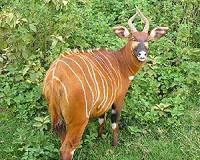| . |  |
. |
East Lansing, Mich. (UPI) Jul 28, 2010 Much of China's suitable panda habitat is outside established nature reserves and areas where wild pandas are reported to live, researchers say. As effort and resources are being expended to protect the endangered giant panda, identifying additional possible habitat for them can aid future conservations efforts, a Michigan State University study released Wednesday said. "This research can help the Chinese government and international non-governmental organizations develop comprehensive strategic plans for more effective conservation of the panda," Jianguo Liu, MSU professor of fisheries and wildlife, said. The joint U.S.-China habitat study was published in the journal Biological Conservation. "Overall, about 40 percent of the suitable habitat for pandas is inside the nature reserves," Andres Vina of MSU's Center for Systems Integration and Sustainability said. "Our model also identified potentially suitable habitat outside the currently accepted geographic range of the panda." Fewer than 1,600 giant pandas live in the wild in three Chinese provinces, Gansu, Shaanxi and Sichuan. Human actions, including logging, residential development and the expansion of farming, are considered the main factors in the contraction of the giant panda's habitat. "The Chinese government plans to add about 69,500 square miles of land to the country's nature reserve system between 2010 and 2020," Zhiyun Ouyang at the Chinese Academy of Sciences in Beijing said. "So opportunities exist to create new reserves, to expand existing reserves and to create corridors that increase the connectivity among the reserves," he said. "On the basis of (the study), we suggest some new areas to be included in China's nature reserve system."
Share This Article With Planet Earth
Related Links Darwin Today At TerraDaily.com
 World's 103 wild mountain antelopes face extinction: Kenya
World's 103 wild mountain antelopes face extinction: KenyaNairobi (AFP) July 29, 2010 Wildlife officials in Kenya warned Thursday that an antelope species, whose entire global wild population of 103 exists only in the east African country, was on the verge of extinction. Habitat loss, genetic factors, predation and disease were threatening to wipe out the mountain bongo (Tragelaphus eurycerus isaaci), the Kenya Wildlife Service (KWS) said in a statement. The elusive mount ... read more |
|
| The content herein, unless otherwise known to be public domain, are Copyright 1995-2010 - SpaceDaily. AFP and UPI Wire Stories are copyright Agence France-Presse and United Press International. ESA Portal Reports are copyright European Space Agency. All NASA sourced material is public domain. Additional copyrights may apply in whole or part to other bona fide parties. Advertising does not imply endorsement,agreement or approval of any opinions, statements or information provided by SpaceDaily on any Web page published or hosted by SpaceDaily. Privacy Statement |